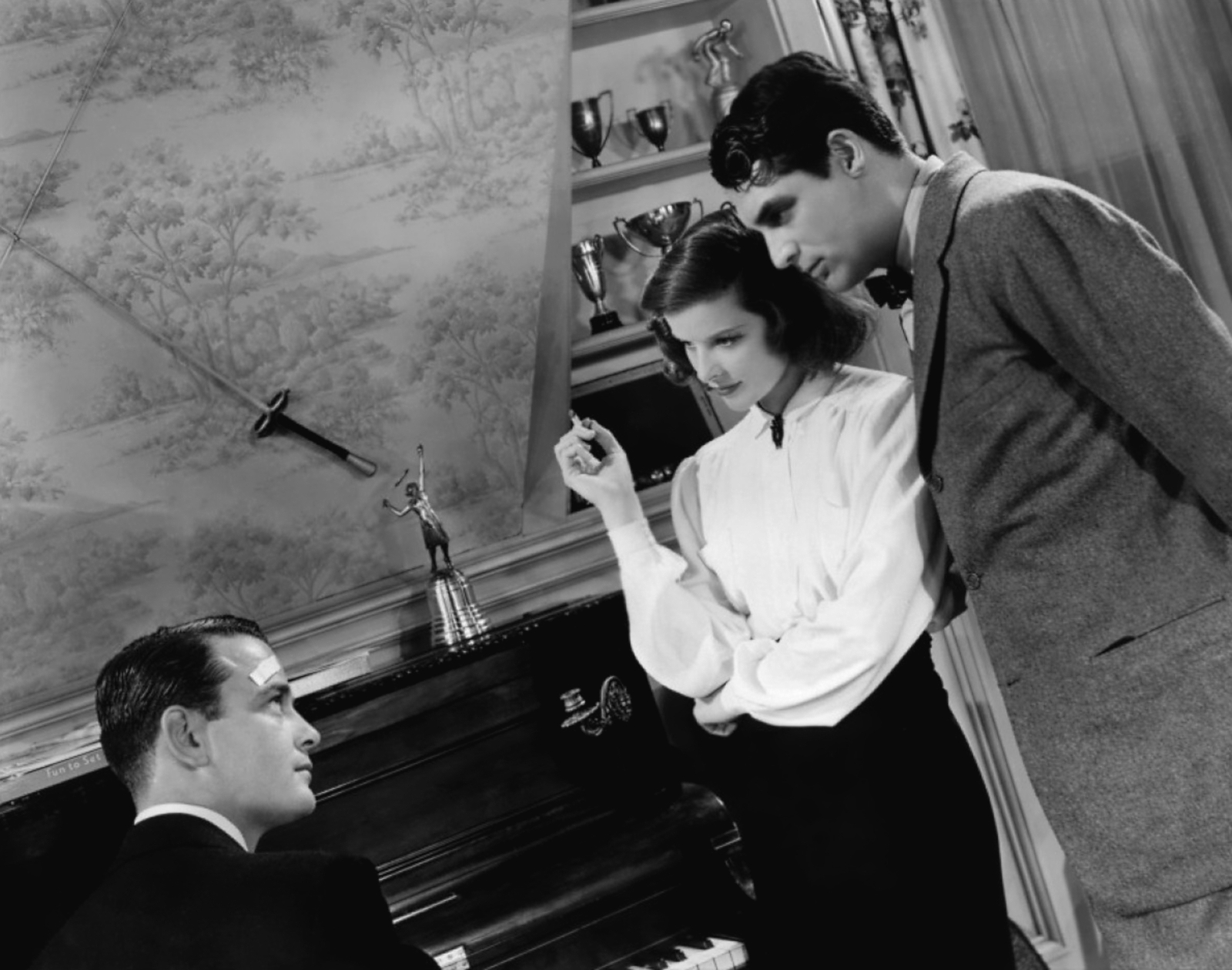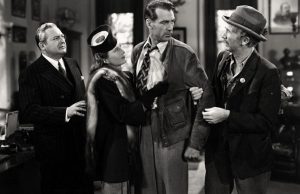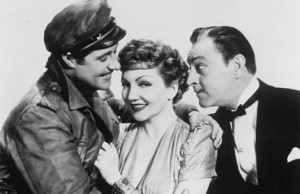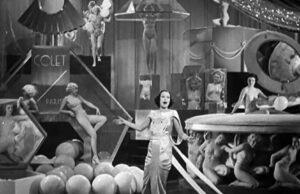Easy Living (1937) and Holiday (1938)
By Toronto Film Society on May 3, 2025
Toronto Film Society presented Easy Living (1937) on Sunday, May 11, 2025 in a double bill with Holiday (1938) as part of the Season 77 Series, Programme 7.
EASY LIVING (1937)
Production Company: Paramount Pictures. Produced by: Arthur Hornblow, Jr. Directed by: Mitchell Leisen. Screenplay by: Preston Sturges. Cinematography: Ted Tedzlaff. Editing: Doane Harrison. Running time: 88 minutes.
Cast: Jean Arthur (Mary Smith), Edward Arnold (J.B. Ball), Ray Milland (John Ball Jr.), Luis Alberni (Mr. Louis Louis), Mary Nash (Mrs. Jenny Ball), Franklin Pangborn (Van Buren), William Demarest (Wallace Whistling).

“Laughter is the shortest distance between two people.” – Victor Borge
Considered a master of the screwball comedy, Preston Sturges wrote Easy Living in 1937. A screwball comedy is characterized by snappy, witty dialogue, romantic ‘battle of the sexes’ storylines accompanied by misunderstandings, misassumptions, misadventures and often hilarious malapropisms (try saying that 3 times fast!).
Sturges’ screenplays and films played a major part in the emergence of this comedy genre in the 1930s and ‘40s. In fact, the filmmaker brothers, Joel and Ethan Coen, credit Sturges’ comedic style and snappy dialogue as a major influence in their work. The title of the Coen Brothers’ film, O Brother, Where Art Thou? (2000) was a nod to Sturges’ Sullivan’s Travels (1941) in which the lead character, movie director John Sullivan, had planned to make a film with that very title.
“Say, what’s the big idea anyway?” “Kismet!”
Translated into “fate, destiny, or the will of God”, Kismet is from Turkish, where it also means fate or destiny; it implies a preordained or unavoidable path in life, often used to describe a chance encounter or coincidence perceived as divine.
Born in Chicago as ‘Edmund Preston Biden’, his eccentric mother, Mary Desti or D’Este, gave Sturges quite the Bohemian childhood. When he was two, she picked up and took him with her to Europe where she annulled her current marriage and pursued a singing career.
When he was four, his mother returned to America and married her 3rd husband, wealthy stockbroker Solomon Sturges, who adopted Preston and changed his surname to Sturges. Not to be tied down, Sturges’ mother returned to Europe; young Sturges found himself bouncing back and forth between Europe and the United States, and attending private boarding schools. Sturges would accompany his mother who would follow her best friend, the famous dancer and choreographer (and rumoured to be a ‘most intriguing bi-sexual’), Isadora Duncan.
Little tidbit: it was Sturges’ mother who gave Isadora Duncan the flowing scarf that became entangled in a car’s wheel and rear axle, pulling Isadora from the open car and snapped her neck.
It might have been Kismet that had Sturges grow up surrounded by culture – dancing, ballet, classical music; maybe it was Kismet that had Sturges attend a succession of boarding schools where he encountered an endless parade of upperclass eccentrics and idle rich who became the characters that populated his films. Kismet, indeed.
The Auteur (pronounced oh-tuhre):
“In film studies, auteur refers to a film director who exerts a high degree of control over the creative aspects of a film, essentially acting as the ‘author’ of the work. Auteur theory posits that the director’s personal vision and style are so prominent that their films bear a distinct stamp of their individual personality and thematic focus.”
Sturges started on Broadway as a playwright and arrived in Hollywood as a screenwriter. At the time, Hollywood screenwriters worked in teams and were tightly controlled by the Studios. Sturges, however, wrote his own screenplays from beginning to end. Dissatisfied with how directors would re-work his rapid-fire dialogue, Sturges was determined to direct his own scripts.
Easy Living was directed by Mitchell Leisen. Originally trained as an architect, Leisen rose to directing from the costume design and art direction departments. Sturges didn’t like Leisen’s handling of his scripts, as Leisen would cut what should stay, and keep what should be cut. Sturges dismissed Leisen as merely an “interior decorator.” Of course, Leisen’s talent for interior design would explain the magnificent sets in Easy Living, particularly inside the Louis Louis hotel.
SPOILER ALERT: the slapstick falls in the bathtub scene were real – Ray Milland couldn’t get out of the tub and kept slipping; it was so funny that Leisen kept the scene in.
Sturges’ success in writing scripts, Easy Living being one of them, afforded Sturges the clout to make a deal. He sold the screenplay and story for The Great McGinty to Paramount for $10 on the condition that he would direct the film. That way, as Sturges once said, another director wouldn’t screw up the dialogue anymore (like Leisen). It should be noted that other notable writers-turned-directors, like Billy Wilder and John Huston, felt the same way. By the time The Great McGinty (1940) was made, Sturges became one of the highest-paid men in Hollywood and one of cinema’s first major auteurs. He was the winner of the very first Academy Award for Writing Original Screenplay for The Great McGinty.
“That?…th-that’s Kolinsky!”
A weasel related to the mink, a Kolinsky is about fifteen inches long with a large bushy tail of about eight to ten inches; it has reddish-brown fur and lives in Siberia and northern China. The lil monsters are vicious predators of rodents, squirrels, and rabbits, but the cuties will also eat insects and fruit. The Kolinsky weasel also has this beautiful fur which has been used for hundreds of years in the fur industry and to make the finest artists brushes.
As the lead character, Mary Smith, spent much of Easy Living with a growling tummy, it’s interesting to note that, in a quick calculation using AI, the $58,000USD price tag in 1937 for that Kolinsky coat would be about $1,004,658.17 CAD in 2025. That’s an awful lot of nickels for the Automat!
“…otherwise, don’t go around putting ideas into people’s mouths”
Speaking of Automats: It was a cafeteria-style chain of restaurants that were particularly popular during the Depression era. Horn & Hardart established the Automat in 1888 and by 1941, there were 157 locations in the New York, Philadelphia and Baltimore areas. The self-serve cafeterias were in business for over a hundred years with the last location closing in 1992; the business model was supplanted by the modern fast food chain industry. In 2023, some enterprising folks started a revival of the Horn & Hardart Automat brand with a vision to one day, open a new location. We’ll have to wait and see!
Notes by Carol Whittaker
HOLIDAY (1938)
Production Company: Columbia Pictures. Director: George Cukor. Producer: Everett Riskin. Screenplay: Donald Ogden Stewart and Sidney Buchman, from the play by Philip Barry. Camera: Franz Planer. Editing: Otto Meyer and Al Clark. Musical Director: Morris Stoloff. Art Director: Stephen Goosson and Lionel Banks. Running time: 95 minutes.
Cast: Katharine Hepburn (Linda Seton), Cary Grant (Johnny Case), Lew Ayres (Ned Seton, Doris Nolan (Julia Seton), Henry Kolker (Edward Seton), Edward Everett Horton (Nick Potter), Jean Dixon (Susan Potter), Henry Daniell (Seton Cram), Binnie Barnes (Laura Cram).

The late Philip Barry was (save for the late S.N. Behrman) America’s most felicitous confector of witty and civilized stage comedies. His three Broadway hits of the late Twenties and early Thirties–Paris Bound, Holiday and The Animal Kingdom–were all filmed with great success by actress Ann Haring and director Edward H. Griffith.
Remade eight years later in the version we are seeing tonight, Holiday may well be the only remake of a movie success that is as good as or better than the original. Techniques for expanding stage works for the film medium had improved since 1930 and director George Cukor took skilled advantage of them; also Donald Ogden Stewart, a good friend of Barry’s and no mean play-wit himself (“Rebound”) not only respected and retained the freshness and sparkle of the play but deftly brought it up to date with references to the CIO and the Depression era–as well as dreaming up such bright new scenes as the church sequence.
The lighter-than-air story (with overtones of anti-conformism) concerns a bright young man, slated to marry the conventional daughter of a wealthy family, who shocks all and sundry with the announcement that, rather than work hard now for a pleasurable retirement, he intends to go on a long holiday now, enjoy life “while I’m young and feel good all the time” and work later–shocks all, that is, but his fiancee’s sympathetic, emancipated older sister, who backs him up with glee.
Kate Hepburn never had a more likeable and form-fitting role than this and she makes an enthusiastic meal of it. Cary Grant, of course, is right in his element as the ingratiating non-conformist, while the oft-wasted Lew Ayres takes sensitive advantage of one of his better opportunities as the sardonic, alcoholic brother. The cast too is enormously strengthened by the happily astringent presence of Edward Everett Horton and Jean Dixon as ebulliently married middle-aged friends of the hero.
Footnotes:
George Cukor had directed Hepburn successfully before in A Bill of Divorcement and Little Women. Although by 1938 she had bee labelled “box-office poison” in the trade, Holiday went over well enough to inspire its star to buy the film rights to Barry’s later comedy The Philadelphia Story which she sold to M-G-M on the condition that she repeat the role she had played on the stage. The rest, as they say, is history, with years of profitable Hepburn stardom at M-G-M, often teamed with Spencer Tracy (in Barry’s Without Love among others), often directed by Cukor (in The Philadelphia Story, Keeper of the Flame, Adam’s Rib, Pat and Mike). Later came memorable performances in The Rainmaker, Suddenly Last Summer, Long Day’s Journey into Night.
George Cukor‘s screen career dates from the early talkies–dialogue director on Milestone’s All Quiet on the Western Front, he was soon making his own films which have included David Copperfield, Camille, Romeo and Juliet, Dinner at Eight, The Women, Susan and God, Born Yesterday, The Marrying Kind, It Should Happen to You, A Star is Born and My Fair Lady.
Notes by George G. Patterson
You may also like...
-
News

Thank You from TFS!
Toronto Film Society | July 21, 2025Our matinée on Sunday, August 17th – at the blessedly air conditioned Paradise Theatre – will conclude the Toronto Film Society’s 77th season! But take heart, as we’ll be...
Programming

Sunday Afternoons at the Paradise
Toronto Film Society | November 10, 2025Join TFS for Season 78’s Sunday Matinée Series generously sponsored by our good friend, author and documentary filmmaker, Mr. Don Hutchison. Please save these dates and visit us regularly...
-
 Toronto Film Society | November 10, 2025
Toronto Film Society | November 10, 2025
-
 Toronto Film Society | November 6, 2022
Toronto Film Society | November 6, 2022
-
 Toronto Film Society | August 1, 2023
Toronto Film Society | August 1, 2023
Donate to Toronto Film Society – We’re now a Registered Charity!
Copyright © 2017 Toronto Film Society.



